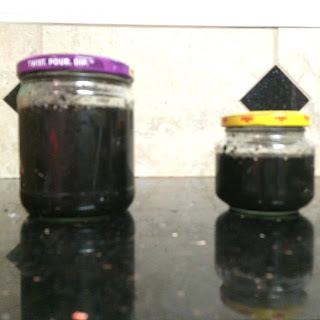Since I used so much saw dust in the layering of the soil layers in my garden along with some of my own, cow, and chicken compost, I was curious whether my soil's pH could be off. I decided I would do some DIY soil testing.
After conducting some research, I settled on two different tests. The soil pH test and soil composition test.
I used this graphic I located on Pinterest.
Here are my two soil samples, mixed as 50% soil/50% water, and shaken. Then I added in one tablespoon of vinegar to one sample and one tablespoon baking soda to the other sample. I continued adding a tablespoon at a time and checking for a reaction.
Then I added in one tablespoon of vinegar to one sample and one tablespoon baking soda to the other sample.
I continued adding a tablespoon at a time and checking for a reaction. I used a teaspoon to stir.
After adding about three tablespoons to each cup (with less less an a cup of sample liquid being tested), I had significant confidence that my soil was neither acidic or alkaline.
Then to be certain I had actually added enough pH material to the mixture to actually affect the pH, I added a spoonful of liquid from one cup to the other and got instant bubbles.
Confident that my soil is balanced, I began then next DIY sample test for soil composition.
I used the website I found
here. I took two soil samples from opposing ends of the raised bed and filled the jars 3/4 full, relative to the size of the jar. I used two different size jars because that is what I had on hand.
Next I added water and detergent and shook well.
Aftern one minute there was no change in the soil separation.
I will take a reading tonight and tomorrow, although I believe I have basically created what is close to potting soil in my garden.
These are the results after one day. I would say it compares pretty closely to the potting soil from the site I used as instructions.
My Samples:
This is the soil samples from http://www.todayshomeowner.com/diy-soil-texture-test-for-your-yard/.
I think I pretty much have potting mix.
As an update, I have added some scraps from my fridge to the top of the hay. I had some carrots, radishes, spinach, and romaine that had gone bad. We'll see if Ms. Ruth Stout's method works. You can see the pieces of carrot in the progress photo below:



























